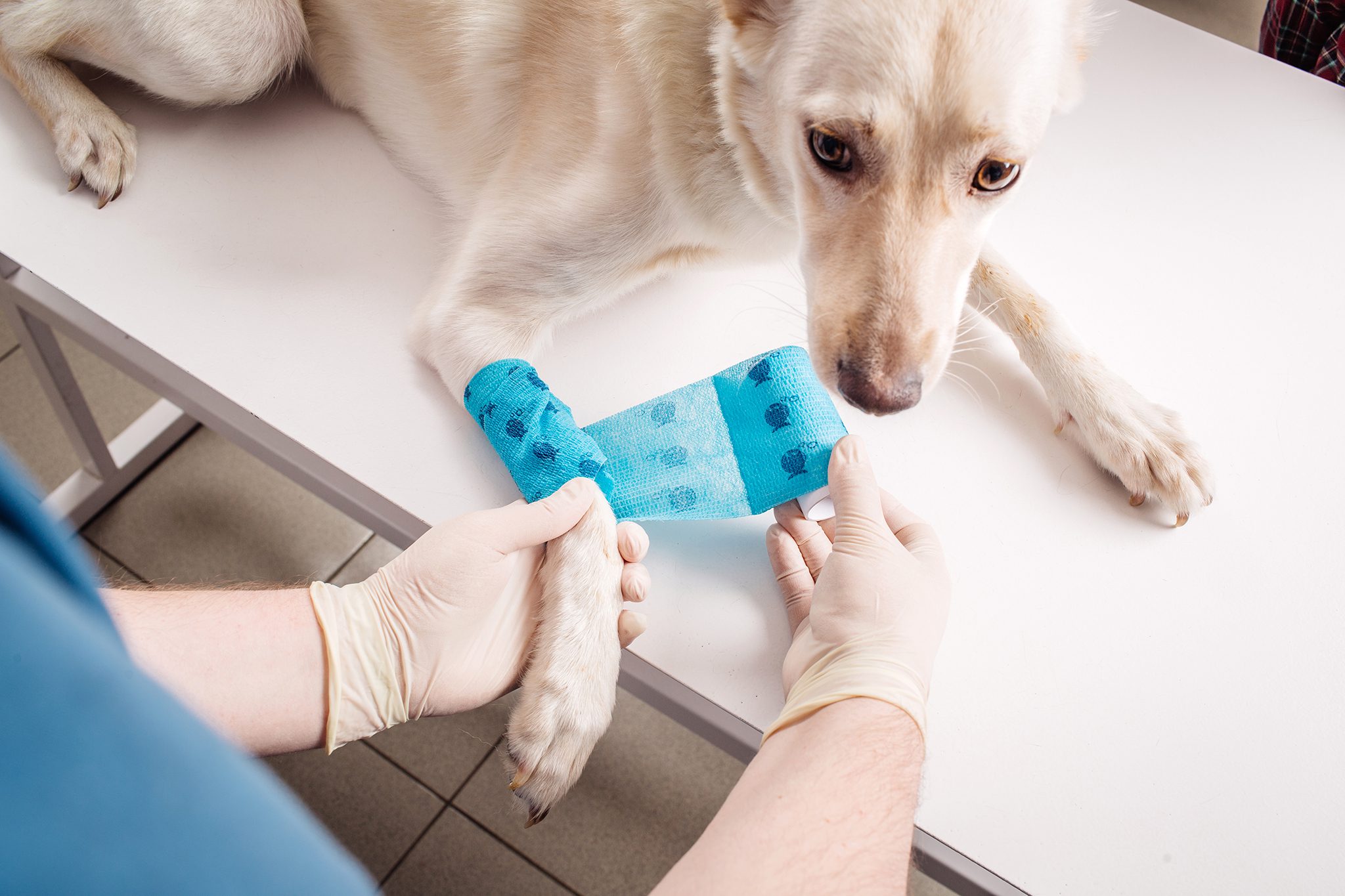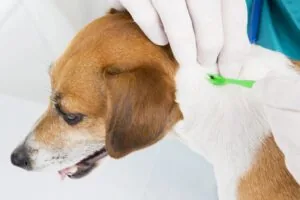Canine First Aid

Emergencies come in all forms, automobile accidents, hit-by-car injuries, bite wounds, burns, heatstroke, poisoning, seizures, and more. It is good to have basic first aid knowledge.
What is first aid?
First aid is the initial treatment given in a medical emergency. The purpose is:
- To preserve life
- To reduce pain and discomfort
- To minimize any risk of permanent disability or disfigurement
Priorities
- Keep calm and try not to panic. If possible, get help so that you can aid your pet while someone helps with restraint, transportation, etc.
- Contact your veterinarian as soon as possible
- If there are suspected internal or limb injuries, keep your pet as still as possible
- Try to keep your pet warm, wrap it in a coat or even a newspaper. Shock often follows most emergencies
- Take your pet to the veterinary hospital as soon as possible
- Drive carefully and observe the speed limit
What is shock?
Shock is a complex condition often following an acute injury or emergency. A life-threatening fall in blood pressure is a dangerous part of shock.
What are the signs of shock?
Clinical signs of systemic shock include rapid breathing and elevated heart rate with pale mucous membranes: gums, lips, or under the eyelids. The feet or ears may feel cold and your pet may vomit and shiver. Most pets become quiet and unresponsive.
What should I do?
Keep the pet as quiet as possible and try to conserve heat by covering it with bedding or newspapers. If necessary, apply the A,B,C of first aid:
A: Airway
B: Breathing
C: Cardiac function
Airway – Anything that obstructs the airway prevents oxygen entering the lungs. Do your best to clear the mouth and throat of any obstruction such as vomit, saliva, or any foreign objects such as grass, sticks, or balls. Be careful; your pet may bite you in panic.
Breathing – If your pet is unconscious and does not appear to be breathing, try gently pumping the chest with the palm of your hand, at the same time feeling just behind the elbow to detect a heartbeat or pulse. Close the muzzle with your hand and blow into the nostrils. This is best accomplished by covering the pet’s nose with your mouth. Be careful! Injured pets may bite out of fear. If you are unsure about the health or vaccination status of the injured pet, avoid contact with bodily fluids and blood.
Cardiac function – If you are unable to detect a heartbeat or pulse or if it appears weak and slow, try pressing on the chest with your palm. Five (5) rapid chest compressions followed by one or two (1-2) deep breaths is a simple form of animal cardio-pulmonary resuscitation (CPR).
Specific First Aid:
Blood loss
Once you have checked A,B,C above and if the bleeding is severe, try to stop it. If bleeding is from a cut pad or paw, apply a dressing using a piece of bandage or clothing. If the bleeding persists and is soaking through the bandage, don’t waste any more time, since this is a medical emergency. Most bleeding wounds will require medical or surgical treatment. If the wounds are treated within four hours, they can often be sutured. Deep cuts treated after four hours have increased risk of infection and complication.
Burns and Scalds
Cool the burned area with cold water as quickly as possible. Cover the burned area with damp towels. If the injury is due to caustic substance, rinse with cold water for fifteen minutes and contact your veterinarian for further advice.
Eye Injuries
Injuries to the eye are always very painful. If a foreign body (grass, awn, sticks, etc.) can be seen, it may be possible to remove it by gently rinsing the eye with eye wash or contact lens saline solution. Seek veterinary advice as soon as possible.
Heat Strokes
This most commonly occurs in hot weather when dogs are left in cars without adequate ventilation. Body temperature rises dramatically. Clinical signs are excessive panting and obvious distress quickly followed by coma and death. Reduce the pet’s body temperature as quickly as possible using cool water and keep the dog wet during transport to the veterinarian. Keep the windows open. Evaporation will help reduce body temperature. Avoid using ice or ice water because this may drop the temperature too quickly and cause additional complications.
Seizures
Seizures can be due to many causes. These range from eclampsia to epilepsy. If due to eclampsia, remove the puppies from the mother immediately.
Symptoms of Dog Seizures
- Running in circles
● Falling to the floor immediately, instead of laying down as usual
● Twitching
● Stiff muscles
● Going completely unconscious
● Being unable to look at you or anything else
● Drooling
● Biting
● Urinating or defecating uncontrollably
● Staring blankly, but remaining standing
If your dog is having a seizure, here’s what you can do to help:
Stay Calm
Don’t get in your dog’s face or cry and yell at them; you may make the situation even more scary than it already is! Sit near your dog, but be careful when petting them, as seizures can cause dogs to bite uncontrollably; they may also bite out of fear, pain, or confusion.
During a seizure, this might mean carefully moving them to a safer location if they’re near the stairs or the edge of the bed. Afterwards, this can mean checking your dog’s body temperature, as seizures can cause it to rise quickly—but only do this once your dog has woken up. To bring it down, place cool washcloths over your dog’s feet.
Speak in low, comforting tones. If your dog seems alert and back to normal, you can also wrap them in a towel or blanket to comfort them.
Keep a Log/Call and Visit Your Vet
Seizures lasting less than two minutes are not usually cause for alarm. Two to five minutes is a warning zone, so take your dog to the vet as soon as possible. Dogs having seizures lasting more than five minutes, or those who have several seizures in the span of a few minutes without waking up should be treated immediately by a vet.
If this is the first time your dog has had a seizure, or if a seizure lasts longer than usual, call your veterinarian immediately and find out if you should bring them in. If you think your dog ingested something toxic that caused a seizure, bring them in right away. Only a vet can tell you why a seizure happened and how to treat it going forward. There might be an easy solution, such as diet or lifestyle changes, or medication if your dog has epilepsy or an underlying disease.
In any situation, it is important to remember to remain calm and be wary around injured animals as they are more likely to respond with aggression. Keep your veterinarians, emergency veterinarian, and poison control number handy.
Share This Post
Recent Posts
About Shallowford Animal Hospital
Shallowford Animal Hospital and The Pet Spa at Shallowford are dedicated to the exceptional, compassionate care your pet deserves. Pets hold a very special place in our families, and we treat yours like our own.



